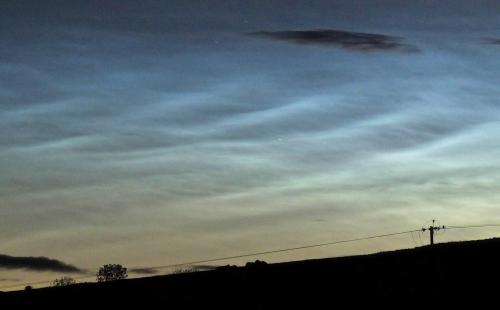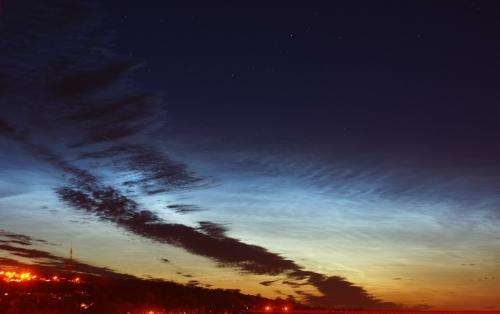Rare noctilucent clouds seen over Northern Ireland

Armagh Observatory reports that rare noctilucent clouds were observed over Northern Ireland on the night of the 30/31 May. The so-called "night shining" clouds take various forms ranging from delicate feathery structures to streamers, ripples and waves, and usually have a silvery grey or electric-blue colour. They are a summer phenomenon which can only be seen at night and when the Sun is between approximately 5 and 15 degrees below the observer's horizon. At our latitudes this means that they often appear low towards the northern horizon during the summer months May to August, either after sunset or before sunrise.
The clouds are caused by sunlight reflecting off ice crystals very high in the Earth's atmosphere, in the region above the stratosphere known as the mesosphere. They typically lie at a height of around 80 kilometres. Any visible lower clouds appear dark, silhouetted against the luminous noctilucent clouds because they are in the Earth's shadow and not illuminated by the Sun.

The origin of noctilucent clouds remains a mystery. The most widely accepted explanation is that they comprise ice crystals that have condensed on tiny meteoric particles, which themselves have come from meteoroids or interplanetary dust impacting the Earth's atmosphere.
One of the many puzzles surrounding noctilucent clouds is that they appear to be a relatively recent meteorological phenomenon, first described as a distinct cloud phenomenon by the astronomer and meteorologist Thomas William Backhouse in 1885. The first recorded observation of such clouds appears to be a note in the Observatory's climate archive made by the third director, the Revd Thomas Romney Robinson, who described "strange luminous clouds in NW, not auroral", seen around 10pm on 1st May 1850.
For more information on these clouds, see article by astronomer John Butler Possible Observations of Noctilucent Clouds by Thomas Romney Robinson - .
For Thomas Romney Robinson's early observation of these clouds, May 1st 1850 - "strange luminous clouds in NW"
Provided by Armagh Observatory





















